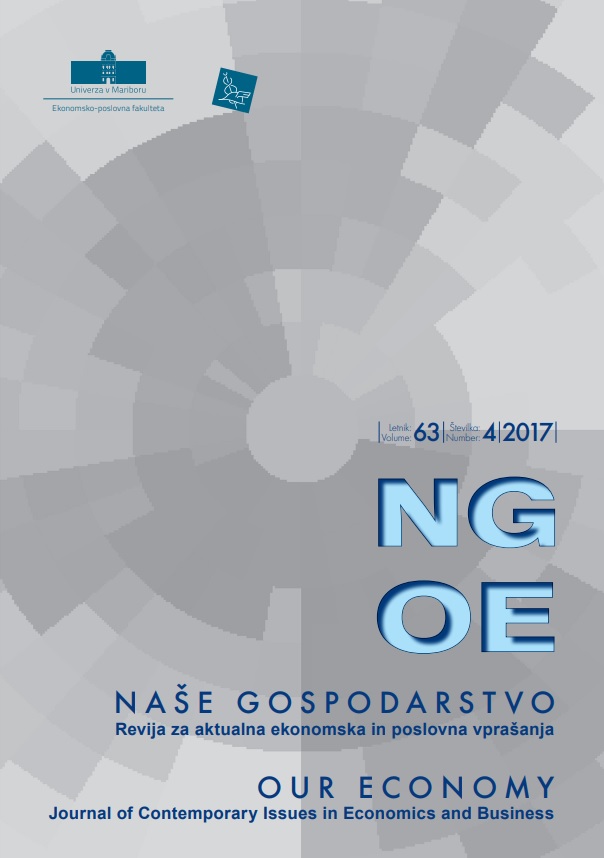Dimensions of Decision-Making Process Quality and Company Performance: A Study of Top Managers in Slovenia
Keywords:
quality of the decision-making process, rationality, motivation, participation, exhaustivity of the information, managers effort, creativity and innovativeness, company stakeholders, company performanceAbstract
This paper investigates the relationship between the dimensions of the decision- making process quality and company performance of top managers’ in Slovenia. We found out that companies whose managers exhibit an above-average dimension of openness of spirit in the quality of the decision making process, on average, have a higher stance on foreign markets as companies in which managers show a below-average open spirit. For the managers who work in companies that are present in foreign markets, we could confirm that there is a low/weak correlation between the dimension of effort of the decision-making process quality and the number of employees in a company.
Downloads
References
Amason, A.C. (1996). Distinguishing the effects of functional and dysfunctional conflict on strategic decision making: resolving a paradox for top management teams. The Academy of Management Journal, 39(1), 123 – 143. https://doi.org/10.2307/256633
Cabantous, L., & Gond, J.-P. (2011). Rational decision making as performance praxis: explaining Rationality’s Eternel Retour. Organization Science, 22(3), 573 – 586. https://doi.org/10.1287/orsc.1100.0534
Cankar, G. & Bajec, B. (2003). Effect size as a supplement to statistical significance testing. Horizons of Psychology, 12(2), 97 – 112. Cohen, J. (1988). Statistical Power Analysis for the Behavioral Sciences. Routledge, New York.
Cohen, J. (1992). A power primer. Psychological Bulletin. 112(1), 155–159. https://doi.org/10.1037/0033-2909.112.1.155
Carifio, J. Perla, R.J. (2007). Ten common misunderstandings, misconceptions, persistent myths and urban legends about Likert scales and Likert response formats and their antidotes, Journal of Social Sciences, 3(3), 106-116. https://doi.org/10.3844/jssp.2007.106.116
Colvin, C. (1997). The most valuable quality in a manager. Fortune, 29 December, 179 – 280.
Cornish, R. (2007). Statistics: 3.1 Cluster Analysis. Mathematics Learning Support Centre. Retrieved from http://www.statstutor.ac.uk/resources/uploaded/clusteranalysis.pdf.
Dean, J.W., and Sharfman, M.P. (1996). Does decision process matter? A study of strategic decision making process. Academy of Management Journal, 39(2), 368 – 396. https://doi.org/10.2307/256784
Driver, M.J., Brousseau, K.R., & Hunsaker, P.L. (1990). The Dynamic Decision Maker: Five Decision Styles for Executive and Business Success. Harper & Row, New York.
Ducker, P.F. (1967). The effective decision. Harvard Business review, 45(January – February) 92 – 98.
Eisenhardt, K.M. (1989). Making fast strategic decisions in high velocity environments. Academy of Management Journal, 32(3), 543 – 576. https://doi.org/10.2307/256434
Gilmore, A. (1998). Quality in management decision making within a changing context. Journal of Management Development, 17(2), 106 –120. https://doi.org/10.1108/02621719810206014
Guillemette, M.G., Laroche, M., and Cadieux, J. (2014). Defining decision making process performance: conceptualization and validation of an index. Information & Management, 51, 618 – 626. https://doi.org/10.1016/j.im.2014.05.012
Harrison, F.E., & Pelletier, M.A. (2000). The essence of management decision’. Management Decision, 38(7), 462 – 469. https://doi.org/10.1108/00251740010373476
Kelley, K. & Preacher, K.J. (2012). On Effect Size. Psychological Methods. 17 (2), 137–152. https://doi.org/10.1037/a0028086
Klingebiel, R., and Meyer, A.D. (2012). Becoming aware of the unknown: decision making during the implementation of a strategic initiative. Organization Science, 24(1), 133 – 153. https://doi.org/10.1287/orsc.1110.0726
Jackson, T. (1991). Measuring Management Performance. A Development Approach for Trainers and Consultants. Kogan Page, London.
Malaska, P., & Holstius, K. (1999). Visionary management, The journal of futures studies, strategic thinking and policy, 1(4), 353 – 361.
Malakooti, B. (2010). Decision making process: typology, intelligence and optimization. Journal of Inteligent Manufacturing, 23(3), 733 –746. https://doi.org/10.1007/s10845-010-0424-1
McLaughlin, D.I. (1995). Strengthening executive decision making. Human Resource Management, 34(3), 443 – 461. https://doi.org/10.1002/hrm.3930340307
Rausch, E., & Anderson, C. (2011). Enhancing decisions with criteria for quality. Management Decision, 49(5), 722 – 733. https://doi.org/10.1108/00251741111130814
Sawilowsky, S. (2009). New effect size rules of thumb. Journal of Modern Applied Statistical Methods, 8(2), 467–474. https://doi.org/10.22237/jmasm/1257035100
Schwenk, C. (1995). Strategic Decision Making. Journal of Management. 21(3), 471 – 493. https://doi.org/10.1177/014920639502100304
Wagner-Mainardes, E., Alves, H., & Raposo, M. (2012). A model for stakeholder classification and stakeholder relationships, Management Decision, 50(10), 1861 – 1879. https://doi.org/10.1108/00251741211279648
Xi, R., & Wunsch II, D.C. (2008). Recent advances in cluster analysis. International Journal of Intelligent Computing and Cybernetics, 1(4), 484 – 508. https://doi.org/10.1108/17563780810919087
Ying-Chieh, C., Shui-Chuan, C., & Ying-Hao, C. (2013). Decision quality by the loss cost of Type I and Type II errors. The TQM Journal, 25(2), 202 – 220. https://doi.org/10.1108/17542731311299627
